Early 20th century French spanking literature
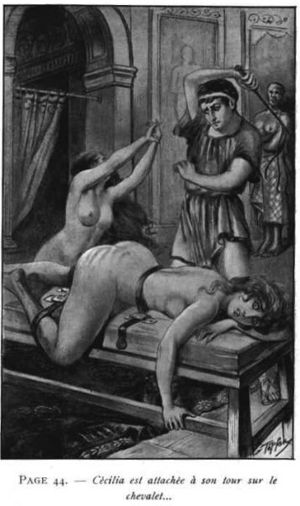
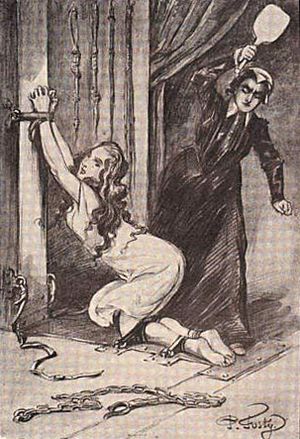
Early 20th century French spanking literature is the first "golden age" of spanking fiction. It began in the early 1900s, grew significantly in the 1920s, reached its peak in the 1930s and came to an end at the outbreak of World War II.
Several things are notable and peculiar about this period. First, it was a very local, French, phenomenon that did not have counterparts in other countries -- not in the UK, not in the Netherlands, and not in Germany either, although we may safely assume these countries must have had a great potential for the same kind of literature.
After 1950, the French book market quickly recovered back to normal, but the genre of spanking literature was left behind. The war, indirectly, must have put an end to the kink-tolerant spirit that had flourished in Paris before. No other country jumped in to fill the gap. The spirit of the 1950s and early 1960s, it seems, was such that people first of all tried to avoid doing anything that could offend anyone. There were individual erotic publications, including some with BDSM themes, but these were exceptions, not a mass phenomenon, and many in fact were banned shortly after they had appeared. 1968 put an end to much of this conservatism, but by then the anti-spanking movement had become so strong that spanking novels were unpublishable for other reasons.
So effectively, the French "golden age of spanking literature" was followed by an artistic and literary gap of 50 years until the 1990s which brought a new, and this time worldwide, boom of spanking literature.
A detailed and high quality source of information on the works, authors and artists of this period, besides the Spanking Art wiki, is Biblio Curiosa which specializes in this French literature genre.
Specifics
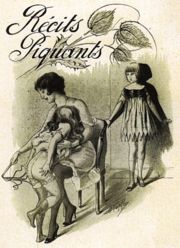
The early 20th century saw a flourishing of spanking fiction in France, catering to a fetishist and spankophile (or as it was called then, flagellant) clientele. The publications were typically in novel or novella form, often illustrated with spanking drawings. They were sold over the counter in selected adult bookshops and by mail order. The heart and center of this literature genre was Paris. There were several publishers and many more imprints under which the novels were published. The authors and illustrators typically used pseudonyms to protect their privacy.
In terms of content, the most popular subject matter of that era seems to have been the corporal punishment of girls (either preteen or post-puberty, between 13 and 17 years of age) by their (mostly female) authority figures. The typical pairing was F/G. The spankings described were harsh (whippings "until the blood came" were not unfrequent) and disciplinary in nature, at least in pretext. At the same time however, they were also often described as a pleasurable and/or erotic experience for both the spanker and, in the case of adolescents, also for the spankee (being past puberty and discovering their sexuality). But any pleasure taken from such corporal punishment was typically hidden, secret or unofficial because the official scenario was normally one of non-consensual disciplinary spanking between an authority figure and their charge.
There is also another aspect that is notable about the spanking literature of that era. Modern spanking literature (since the late 20th century) often places the spankee into the focus: the reader is interested in what the spankee feels and experiences, physically and emotionally. The spankee is the protagonist and in the course of a longer story or novel, will often be spanked by different spankers, each giving a somewhat different experience.
In the erotic spanking literature of the early 20th century, the authors usually focused on the spanker, who is as a rule a dominant and a very attractive woman. The spankees are more or less objects to her: proof of the spanker's power. In the course of a longer story or novel, the spanker will often punish different spankees in different, creative ways.
Besides the obvious physical nature of corporal punishment, the works always placed a strong emphasis on the emotional side of it: the feelings of shame, embarrassment and humiliation that came with such punishment. Individual works of the genre also addressed "related" fetishes such as bondage, imprisonment, enemas or petticoat punishment.
Reprints and translations
[[Image:G Topfer Les Malheurs de Colette.jpg|thumb|Illustration by Georges Topfer and title page of Les Malheurs de Colette by Aimé Van Rod.]] These books were written in French, and only a limited number were later translated to other languages such as English or German. Some novels saw reprints after World War II, up to the 1970s. Today, some of the works of this period have entered the public domain (depending on the year of death, or where unknown of the last known publication, of their copyright holder), making it legal for everyone to use and republish them.
A good source for used books of that period is Abebooks. Selected novels are also available for purchase in e-book form on Eros-Thanatos.
Publishers
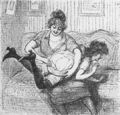
- Paul Brenet (imprints: Éditions P. Brenet, Librairie Artistique, Édition Parisienne, Librairie Artistique et Édition Parisienne Réunies, Librairie Générale (probably)
- Cercle du Livre Précieux
- Charles Carrington (Paul Harry Ferdinando)
- Jean Fort (many imprints including his best known Collection des Orties Blanches)
- Pierre Guénolé
- Select Bibliothèque (Roland Brévannes?)
Authors
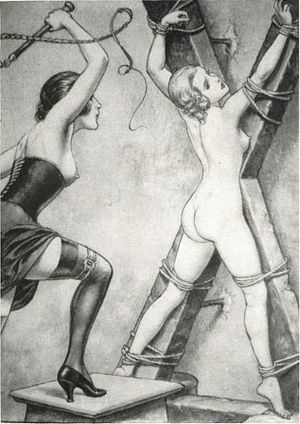
- Carlo Albérica
- Don Brennus Aléra (Bernard Valonnes, Roland Brévannes?)
- Maurice d'Apinac
- P. Beloti (Paulette Vergès)
- Lord Birchisgood
- Jean Bustarès
- Victor du Cheynier
- Jean Claqueret
- René-Michel Desergy
- Pierre Dumarchey (Pierre Mac Orlan, Pierre du Bourdel, Sadie Blackeyes, Pierre de Jusange, Doctor Fowler, Sadinet, Claude de Saint-Hieble (in L'Instrument des apothicaires, Jean Fort, 1920), Chevalier de X)
- Pierre Guénolé
- Liane Lauré
- James Lovebirch
- Alan Mac Clyde
- Louis Malteste (Jacques d'Icy)
- Jean Martinet
- Jean de Merlin
- Bernard Montorgueil
- Gilbert Natès
- Aimé Van Rod
- René Schwaeblé
- Max des Vignons
- Jean de Villiot (collective pseudonym)
- Maurice de Vindas
- Jean de Virgans
- Charles Virmaître
Illustrators
- Don Brennus Aléra (Tack, Esbey and Selby; Roland Brévannes?)
- Lewis Bald
- P. Beloti
- Édouard Bernard
- Carlo
- René-Michel Desergy
- Pierre Dumarchey (Jean Macorlan)
- J. X. Dumoulin
- P. Fusty
- René Giffey
- Pierre Guénolé
- C. Helsey
- Chéri Hérouard (Herric)
- Charles Hirlemann
- Luc Lafnet (Jim Black, Viset, Lucas O)
- Etienne Le Rallic (R. Fanny)
- Martin van Maële (René Gockinga)
- Louis Malteste (Ignotus)
- Bernard Montorgueil
- Leon Pierre
- M.-K. Sc.
- Sergisky
- Georges Topfer (Gaston Smit)
Selected Works
- Woman and Her Master (1904) by Jean de Villiot, pseudonym of Georges Grassal. A novel of flagellation erotica translated into English by Charles Carrington from the original 1902 French edition, La Femme et son maître.
- Birch in the Boudoir (1905) by Anonymous (attributed to Hugues Rebell, real name Georges Grassal), translated and published in Paris by Charles Carrington. Reprinted in 1989 by Blue Moon Books as Beauty in the Birch. An exchange of racy letters about the amatory and disciplinary experiences of a new master of an English school for wayward girls and a woman living in an Arabian harem.
- The Mistress and The Slave (1905) by George Merder. A study of female domination and sadomasochism as an upper-class businessman is enslaved and brutalized by a Parisian street-girl. Translated from the original French edition, La Maitresse et l'Esclave (Maison Mystere, ca. 1903).
- La Flagellation Passionnelle (1906) by Don Brennus Aléra, pseudonym of Roland Brévannes. Between 1903 and 1936 he wrote and illustrated around 100 historical and contemporary novels about flagellation and crossdressing petticoat punishment.
- Nos Belles flagellantes (1907) by Aimé Van Rod (Édition Parisienne: Paris). French author of dozens of flagellation novels including: Nouveax Contes de Fouet (1907), The Conjugal Whip (Le fouet conjugal) (1908), Le Fouet dominateur ou L'École des vierges, Les Mystéres du Fouet (both 1909), The Humiliations of Miss Madge (1912), Les Malheurs de Colette (1914), Visites Fantastiques au Pays du Fouet (1922), Le Precepteur (1923), Memories d'une Fouettee (1924), et al.
- La Comtesse au fouet (1908), by Pierre Dumarchey (Pierre Mac Orlan). The story of a cruel dominatrix who turns the male hero into a "dog-man". Under the pen-name Miss Sadie Blackeyes, he wrote popular flagellation novels such as Baby douce fille (1910), Miss: The memoirs of a young lady of quality containing recollections of boarding school discipline and intimate details of her chastisement (1912), and Petite Dactylo et autres textes de flagellation (1913). And as "anonymous" he wrote Masochists in America (Le Masochisme en Amérique: Recueil des récits et impressions personnelles d'une victime du féminisme) (1905).
- Éducation Anglaise (1908) by Lord Kidrodstock (Édition Parisienne: Paris); early and unusual text featuring forced cross-dressing and flagellation. Boys and girls in an English boarding school are dressed alike in girl’s clothes, tight corsets, narrow high-heeled boots, etc.
- Coups de Fouet (1908) by Lord Birchisgood [pseud.] (Édition Parisienne, Roberts & Dardailons Éditeurs: Paris). Author of Le Tour d'Europe d'un flagellant (1909), et al.
- Esclaves Modernes (1910) by Jean de Virgans; unusual power exchange story with white European women whipped and abused by African natives. Virgans wrote dozens of flagellation novels.
- Les Cinq fessées de Suzette (Five Smackings of Suzette) (1910) by James Lovebirch [pseud.], published in Paris. Author of many popular flagellation novels such as L'Avatar de Lucette, Peggy Briggs, Au Bon Vieux Temps (all from 1913), and The Flagellations of Suzette (1915), Paris: Library Aristique.
- Le Fouet au Couvent (1911) by Aimé Van Rod [pseud.]. (Édition Parisienne, Roberts & Dardaillon, illustrated by Georges Topfer). One of many novels by Van Rod that mixes perverse religiosity and flagellation.
- Qui Aime Bien (1912) by Jacques d'Icy, pseudonym of author and artist Louis Malteste (Jean Fort: Paris), illustrated by Maltese. Writer of many books of spanking/whipping erotica such as: Chatie Bien (1913), Monsieur Paulette et Ses Epouses (1921), Paulette Trahie (1922), Brassée de faits (1925), Les Mains Chéries (1927), et al.
- Le règne de la cravache et de la bottine (The Reign of the Riding Crop and the Boot) (1913) by Roland Brévannes, pseudonym of Bernard Valonnes (Select Bibliothèque: Paris); humiliating animal roleplay, female-dominated men are forced to crawl about in bear suits. A theme explored in several of his books; in Les Esclaves-montures (Slave Mountings) (1920) and Le Club des Monteurs Humaines (1924), men are turned into obedient cart ponies.
- Sévère Éducation (1928) by René-Michel Desergy (Paris, Collection des Orties Blanches) — illustrations by N. Carman
- Le Dressage de la Maid-Esclave (1930) by Bernard Valonnes, pseudonym of Roland Brévannes (Select Bibliotheque: Paris); two-volume story of pony play with women trained as cart-pulling slaves.
- The Discipline of Odette (1930) by Jean Martinet [pseud.] (Éditions Prima); English translation of the French whipping/spanking novel Matée par le fouet.
- Bagne de femmes (Jail for Girls) (1931) by Alan Mac Clyde [pseud.], Librairie Générale: Paris. One of the earliest of dozens of sadomasochistic novels by this unknown author. Followed by Dressage (1931), La Cité de l'horreur (1933), Servitude (1934), Dolly, Esclave (1936), et al.
- Dresseuses d'hommes (1931) by Florence Fulbert (Jean Fort: Paris), illustrated by Jim Black, aka Luc Lafnet. Femdom story of men dominated and punished by women.
See also
Chat rooms • What links here • Copyright info • Contact information • Category:Root

